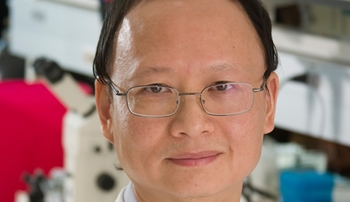For decades, it has been held by the scientific community that the type 2 receptor (AT2) of the peptide hormone Angiotensin II contributes primarily to embryonic development.
In animal models, the AT2 receptor is highly expressed in the fetus and dramatically declines and disappears after birth. This has been widely accepted in the scientific literature and by those working in the field.
But, said Lie Gao, Ph.D., assistant professor of cellular and integrative physiology, “As a scientist, the big job is to find some new thing.”
 |
Lie Gao, Ph.D. |
So Dr. Gao with the assistance of his wife, research technologist Li Yu, did some experiments. And … nothing.
“We were very disappointed,” Dr. Gao said.
This is how most experiments go.
But then Dr. Gao’s colleague, George Rozanski, Ph.D., professor of cellular and integrative physiology, provided some rat fetal tissue.
The new experiments, this time with rat fetal tissue, showed lower, not higher, AT2 receptor expression. “This confused us,” Dr. Gao said. They tried it again and again. Three times – the results were stable, always the same.
And, they were always the opposite of the previously-held conventional wisdom that the AT2 receptor was higher in the fetal compared to the adult.
This was an exciting new finding.
And so, on March 7, Dr. Gao will receive UNMC’s 2013 Joseph. P. Gilmore Distinguished New Investigator award.
“I appreciate the Gilmore family,” Dr. Gao said. “It is recognition like this that spurs us on to more and greater research.”
Dr. Gao next hopes to collaborate with physicians, in order to further apply these findings into clinical work.
Angiotensin II is the peptide that plays an important role in the regulation of blood pressure and water balance. Preliminary data suggests that AT2 receptors may also enhance insulin secretion. The Gao laboratory’s preliminary findings, if proven true, may be applicable toward a novel therapeutic strategy for chronic heart failure and diabetes.
But, how? How could the Gao lab come up with findings that were the opposite of decades of accepted science?
Previous experiments studied AT2 receptors in rats using skin samples. But Dr. Gao focused on other tissues and organs, and found what no one had before.
There is still a long way to go, if these findings are to be accepted as the new standard. Still, it’s exciting.
“It feels,” Dr. Gao said, “like you are the first one to know a secret.”